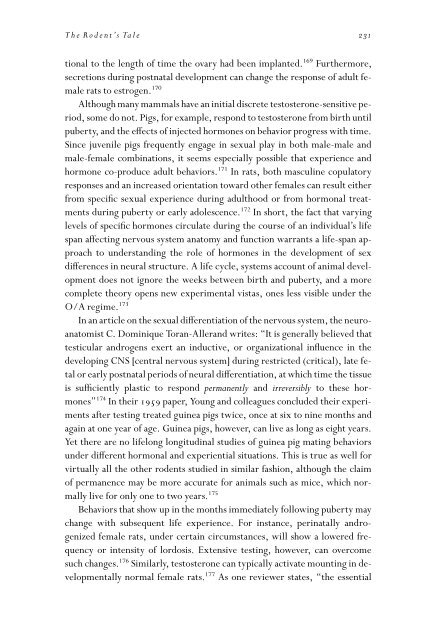- Page 2 and 3:
Copyright C 2ooo by Anne Fausto-Ste
- Page 4 and 5:
'"' Conrenrs Nous I lSJ Biblioaraph
- Page 6 and 7:
x Preface nevertheless urge everyon
- Page 8 and 9:
xii Acknowledgments have helped me
- Page 10 and 11:
2 S EXING THE B ODY Down but not ou
- Page 12 and 13:
4 S EXING THE B ODY as boys, the pr
- Page 14 and 15:
6 S EXING THE B ODY vidual body, an
- Page 16 and 17:
8 S EXING THE B ODY psychology, and
- Page 18 and 19:
10 S EXING THE B ODY ality remained
- Page 20 and 21:
12 S EXING THE B ODY Written in the
- Page 22 and 23:
14 S EXING THE B ODY and nervous il
- Page 24 and 25:
16 S EXING THE B ODY contemporary U
- Page 26 and 27:
18 S EXING THE B ODY ‘‘cultural
- Page 28 and 29:
20 S EXING THE B ODY gender—in th
- Page 30 and 31:
22 S EXING THE B ODY structure . .
- Page 32 and 33:
24 S EXING THE B ODY FIGURE 1.3: M
- Page 34 and 35:
26 S EXING THE B ODY How, specifica
- Page 36 and 37:
28 S EXING THE B ODY telling them t
- Page 38 and 39:
2 ‘‘THAT SEXE WHICH PREVAILETH
- Page 40 and 41:
32 S EXING THE B ODY FIGURE 2.1: Sl
- Page 42 and 43:
34 S EXING THE B ODY with interacti
- Page 44 and 45:
36 S EXING THE B ODY pate in the po
- Page 46 and 47:
38 S EXING THE B ODY Pseudohermaphr
- Page 48 and 49:
40 S EXING THE B ODY were demanding
- Page 50 and 51:
42 S EXING THE B ODY on the gonads
- Page 52 and 53:
44 S EXING THE B ODY Although less
- Page 54 and 55:
46 S EXING THE B ODY that ‘‘whi
- Page 56 and 57:
48 S EXING THE B ODY Luckily for th
- Page 58 and 59:
50 S EXING THE B ODY FIGURE 3.3: Th
- Page 60 and 61:
52 TABLE 3.1 Some Common Types of I
- Page 62 and 63:
54 S EXING THE B ODY varies widely
- Page 64 and 65:
56 S EXING THE B ODY seventy-five h
- Page 66 and 67:
58 S EXING THE B ODY surgery should
- Page 68 and 69:
60 S EXING THE B ODY TABLE 3.3 Rece
- Page 70 and 71:
62 S EXING THE B ODY FIGURE 3.6: Re
- Page 72 and 73:
64 S EXING THE B ODY their child’
- Page 74 and 75:
66 S EXING THE B ODY dren.’’ An
- Page 76 and 77:
68 S EXING THE B ODY Models of Psyc
- Page 78 and 79:
70 S EXING THE B ODY psychiatrists
- Page 80 and 81:
72 S EXING THE B ODY as one histori
- Page 82 and 83:
74 S EXING THE B ODY how intersexua
- Page 84 and 85:
76 S EXING THE B ODY sized penises
- Page 86 and 87:
4 SHOULD THERE BE ONLY TWO SEXES x
- Page 88 and 89:
80 S EXING THE B ODY implausible is
- Page 90 and 91:
TABLE 4.1 Outcomes of Reduction Cli
- Page 92 and 93:
84 S EXING THE B ODY patients and w
- Page 94 and 95:
86 S EXING THE B ODY goal. 37 In ou
- Page 96 and 97:
TABLE 4.2 Evaluation of Vaginoplast
- Page 98 and 99:
TABLE 4.2 (Continued) 90 # OF AGE A
- Page 100 and 101:
92 S EXING THE B ODY The Right To R
- Page 102 and 103:
94 S EXING THE B ODY FIGURE 4.1: Fr
- Page 104 and 105:
TABLE 4.3 Psychological Outcomes of
- Page 106 and 107:
TABLE 4.3 (Continued) DEVELOPMENTAL
- Page 108 and 109:
TABLE 4.3 (Continued) 100 DEVELOPME
- Page 110 and 111:
TABLE 4.4 Psychological Outcomes of
- Page 112 and 113:
TABLE 4.4 (Continued) 104 DEVELOPME
- Page 114 and 115:
TABLE 4.4 (Continued) 106 DEVELOPME
- Page 116 and 117:
108 S EXING THE B ODY tions and eve
- Page 118 and 119:
110 S EXING THE B ODY Toward the En
- Page 120 and 121:
112 S EXING THE B ODY and a woman,
- Page 122 and 123:
114 S EXING THE B ODY and methods.
- Page 124 and 125:
116 S EXING THE B ODY taken from ou
- Page 126 and 127:
118 S EXING THE B ODY At first ever
- Page 128 and 129:
120 S EXING THE B ODY TABLE 5.1 Nin
- Page 130 and 131:
122 S EXING THE B ODY anatomical la
- Page 132 and 133:
124 S EXING THE B ODY Mall engaged
- Page 134 and 135:
126 S EXING THE B ODY FIGURE 5.3: A
- Page 136 and 137:
TABLE 5.3 Absolute Sex Differences
- Page 138 and 139:
130 S EXING THE B ODY Genu Isthmus
- Page 140 and 141:
TABLE 5.4 Relative Sex Differences
- Page 142 and 143:
TABLE 5.5 Hand Preference, Sex, and
- Page 144 and 145:
136 S EXING THE B ODY law-abiding a
- Page 146 and 147:
138 S EXING THE B ODY they would us
- Page 148 and 149:
140 S EXING THE B ODY Well, 66 perc
- Page 150 and 151:
142 S EXING THE B ODY GENDER DIFFER
- Page 152 and 153:
GENDER DIFFERENCES GENDER DIFFERENC
- Page 154 and 155:
6 SEX GLANDS, HORMONES, AND GENDER
- Page 156 and 157:
148 S EXING THE B ODY Scientists di
- Page 158 and 159:
150 S EXING THE B ODY FIGURE 6.1: B
- Page 160 and 161:
152 TABLE 6.1 Thinking About Sex an
- Page 162 and 163:
154 S EXING THE B ODY plasms differ
- Page 164 and 165:
156 S EXING THE B ODY he considered
- Page 166 and 167:
158 S EXING THE B ODY much of the e
- Page 168 and 169:
TABLE 6.2 Steinach’s Experiments
- Page 170 and 171:
162 S EXING THE B ODY stronger than
- Page 172 and 173:
164 S EXING THE B ODY The naturally
- Page 174 and 175:
TABLE 6.3 Moore’s Transplantation
- Page 176 and 177:
168 S EXING THE B ODY less certain
- Page 178 and 179:
7 DO SEX HORMONES REALLY EXIST (GEN
- Page 180 and 181:
172 S EXING THE B ODY The early twe
- Page 182 and 183:
174 S EXING THE B ODY became Superi
- Page 184 and 185:
176 S EXING THE B ODY women’s rig
- Page 186 and 187:
178 S EXING THE B ODY In 1939 CRPS
- Page 188 and 189: 180 S EXING THE B ODY FIGURE 7.3: P
- Page 190 and 191: 182 S EXING THE B ODY mones came in
- Page 192 and 193: 184 S EXING THE B ODY sugar, the fe
- Page 194 and 195: 186 S EXING THE B ODY the role of s
- Page 196 and 197: 188 S EXING THE B ODY FIGURE 7.5: N
- Page 198 and 199: 190 S EXING THE B ODY which denoted
- Page 200 and 201: 192 S EXING THE B ODY the very thin
- Page 202 and 203: 194 S EXING THE B ODY steroids as o
- Page 204 and 205: 196 S EXING THE B ODY consolidated
- Page 206 and 207: 198 S EXING THE B ODY Sexual chaos
- Page 208 and 209: 200 S EXING THE B ODY omy in rabbit
- Page 210 and 211: 202 S EXING THE B ODY had no ovarie
- Page 212 and 213: 204 S EXING THE B ODY equated with
- Page 214 and 215: 206 S EXING THE B ODY measure hormo
- Page 216 and 217: 208 S EXING THE B ODY ‘‘environ
- Page 218 and 219: 210 S EXING THE B ODY FIGURE 8.2: B
- Page 220 and 221: 212 S EXING THE B ODY Young, who ob
- Page 222 and 223: 214 S EXING THE B ODY for anatomica
- Page 224 and 225: 216 S EXING THE B ODY activators. T
- Page 226 and 227: 218 S EXING THE B ODY and female ro
- Page 228 and 229: 220 S EXING THE B ODY Many of them
- Page 230 and 231: 222 S EXING THE B ODY androgen on t
- Page 232 and 233: 224 S EXING THE B ODY While Beach
- Page 234 and 235: 226 S EXING THE B ODY 1920s, by the
- Page 236 and 237: 228 S EXING THE B ODY FIGURE 8.6: A
- Page 240 and 241: 232 S EXING THE B ODY ‘wiring’
- Page 242 and 243: FIGURE 9.1: A budding scientist (So
- Page 244 and 245: 236 S EXING THE B ODY DNA needed an
- Page 246 and 247: 238 S EXING THE B ODY FIGURE 9.2: S
- Page 248 and 249: 240 S EXING THE B ODY In other word
- Page 250 and 251: 242 S EXING THE B ODY ponents and n
- Page 252 and 253: 244 S EXING THE B ODY others to ‘
- Page 254 and 255: 246 S EXING THE B ODY with other hu
- Page 256 and 257: 248 S EXING THE B ODY popped into m
- Page 258 and 259: 250 S EXING THE B ODY gender can mo
- Page 260 and 261: 252 S EXING THE B ODY with another
- Page 262 and 263: 254 S EXING THE B ODY FIGURE 9.4: T
- Page 264 and 265: notes Chapter 1: Dueling Dualisms 1
- Page 266 and 267: Notes 259 (and are) suspicious of g
- Page 268 and 269: Notes 261 a veil that he refers to
- Page 270 and 271: Notes 263 22 percent of women repor
- Page 272 and 273: Notes 265 in previous historical er
- Page 274 and 275: Notes 267 account of the history of
- Page 276 and 277: Notes 269 93. Stein 1998. For a ful
- Page 278 and 279: Notes 271 note that this approach t
- Page 280 and 281: Notes 273 important. They urge caut
- Page 282 and 283: Notes 275 26. Dreger 1998b. 27. Quo
- Page 284 and 285: Notes 277 tailed yet accessible boo
- Page 286 and 287: Notes 279 B. In females 1.Absence o
- Page 288 and 289:
Notes 281 36. Mercado et al. 1995.
- Page 290 and 291:
Notes 283 cluding that which we ter
- Page 292 and 293:
Notes 285 98. Money and Ehrhardt 19
- Page 294 and 295:
Notes 287 system. As I discuss in t
- Page 296 and 297:
Notes 289 masculine behavior’’
- Page 298 and 299:
Notes 291 Berenbaum and Hines’s m
- Page 300 and 301:
Notes 293 ‘‘early hormone expos
- Page 302 and 303:
Notes 295 injection is not discusse
- Page 304 and 305:
Notes 297 Three of the twelve appar
- Page 306 and 307:
Notes 299 Holmes chose to go public
- Page 308 and 309:
Notes 301 operation, refers to ‘
- Page 310 and 311:
Notes 303 51. Slijper et al. 1998,p
- Page 312 and 313:
Notes 305 68. Actually, this moment
- Page 314 and 315:
Notes 307 99. See de la Chapelle 19
- Page 316 and 317:
Notes 309 antilocalizers cheered th
- Page 318 and 319:
Notes 311 38. In1999 it is the sple
- Page 320 and 321:
Notes 313 popular PET scans are con
- Page 322 and 323:
Notes 315 64. Halpern (1998), p. 33
- Page 324 and 325:
Notes 317 France and England as the
- Page 326 and 327:
Notes 319 removed from that of Amer
- Page 328 and 329:
Notes 321 zie, Rule’s Q is most p
- Page 330 and 331:
Notes 323 evolution of brain asymme
- Page 332 and 333:
Notes 325 nature/nurture dichotomy
- Page 334 and 335:
Notes 327 literature on social worl
- Page 336 and 337:
Notes 329 driving force in many agi
- Page 338 and 339:
Notes 331 a story of quackery. Nor,
- Page 340 and 341:
Notes 333 came Dean of Biological S
- Page 342 and 343:
Notes 335 human biology, with virtu
- Page 344 and 345:
Notes 337 sion of Medical Sciences.
- Page 346 and 347:
Notes 339 mal, while all other form
- Page 348 and 349:
Notes 341 59. Frank and Goldberger
- Page 350 and 351:
Notes 343 93. While most readers ar
- Page 352 and 353:
Notes 345 15. Schlesinger 1958, p.6
- Page 354 and 355:
Notes 347 kind of struggle against
- Page 356 and 357:
Notes 349 ever, that in mice neithe
- Page 358 and 359:
Notes 351 Beach’s work and manner
- Page 360 and 361:
Notes 353 the majority of the femal
- Page 362 and 363:
Notes 355 ability to substitute for
- Page 364 and 365:
Notes 357 Here I discuss only matin
- Page 366 and 367:
Notes 359 heat . . . duration of ma
- Page 368 and 369:
Notes 361 In addition to attacking
- Page 370 and 371:
Notes 363 127. Clark 1993b, p. 37.
- Page 372 and 373:
Notes 365 the altered testosterone
- Page 374 and 375:
Notes 367 treatment (van de Poll et
- Page 376 and 377:
Notes 369 to understanding relation
- Page 378 and 379:
Notes 371 the brain—a region of t
- Page 380 and 381:
Notes 373 neuromuscular development
- Page 382 and 383:
Notes 375 der prophecies based on s
- Page 384 and 385:
Notes 377 to present-day studies on
- Page 386 and 387:
Notes 379 ties. Taylor, however, re
- Page 388 and 389:
382 Bibliography Abu-Arafeh, W., B.
- Page 390 and 391:
384 Bibliography Azziz, R., R. Mula
- Page 392 and 393:
386 Bibliography ———. 1968. T
- Page 394 and 395:
388 Bibliography Berenson, A., A. H
- Page 396 and 397:
390 Bibliography Breines, W. 1992.
- Page 398 and 399:
392 Bibliography ———. 1999. R
- Page 400 and 401:
394 Bibliography Corner, G. W. 1964
- Page 402 and 403:
396 Bibliography Deanesly, R., and
- Page 404 and 405:
398 Bibliography Dorsey, G. A. 1925
- Page 406 and 407:
400 Bibliography Elias, S., and G.
- Page 408 and 409:
402 Bibliography ally dimorphic beh
- Page 410 and 411:
404 Bibliography on its purificatio
- Page 412 and 413:
406 Bibliography development: A dev
- Page 414 and 415:
408 Bibliography Gustavson, R. G. 1
- Page 416 and 417:
410 Bibliography Hansen, B. 1989. A
- Page 418 and 419:
412 Bibliography Hill, R. T. 1937a.
- Page 420 and 421:
414 Bibliography mission of active
- Page 422 and 423:
416 Bibliography Jost, A., and Y. B
- Page 424 and 425:
418 Bibliography Klein, M., and A.
- Page 426 and 427:
420 Bibliography olution. In Discou
- Page 428 and 429:
422 Bibliography Lott, B., and D. M
- Page 430 and 431:
424 Bibliography Martin, J. B. 1993
- Page 432 and 433:
426 Bibliography ———. 1956. S
- Page 434 and 435:
428 Bibliography ual Differentiatio
- Page 436 and 437:
430 Bibliography Oppenheim, J. S.,
- Page 438 and 439:
432 Bibliography Phoenix, C. 1978.
- Page 440 and 441:
434 Bibliography Reilly, J. M., and
- Page 442 and 443:
436 Bibliography Russett, C. E. 198
- Page 444 and 445:
438 Bibliography Simpson, J. L. 198
- Page 446 and 447:
440 Bibliography ———. 1913. P
- Page 448 and 449:
442 Bibliography feminist perspecti
- Page 450 and 451:
444 Bibliography Van den Wijngaard,
- Page 452 and 453:
446 Bibliography Werner, M. H., J.
- Page 454 and 455:
448 Bibliography gic modulation of
- Page 456 and 457:
452 Index Moore cited by, 353(n65)
- Page 458 and 459:
454 Index clitoral recession, 60(ta
- Page 460 and 461:
456 Index Earhart, Amelia, 192 Eder
- Page 462 and 463:
458 Index Money and Ehrhardt’s de
- Page 464 and 465:
460 Index Hausman, Bernice, 23 Hawk
- Page 466 and 467:
462 Index clinical features, 52(tab
- Page 468 and 469:
464 Index Lichtenstern, R., 163, 33
- Page 470 and 471:
466 Index Nerve cells. See Brain; C
- Page 472 and 473:
468 Index sexual preference in, 225
- Page 474 and 475:
470 Index Young’s research/theori
- Page 476 and 477:
472 Index Uecker, A., 324(n104) Und





